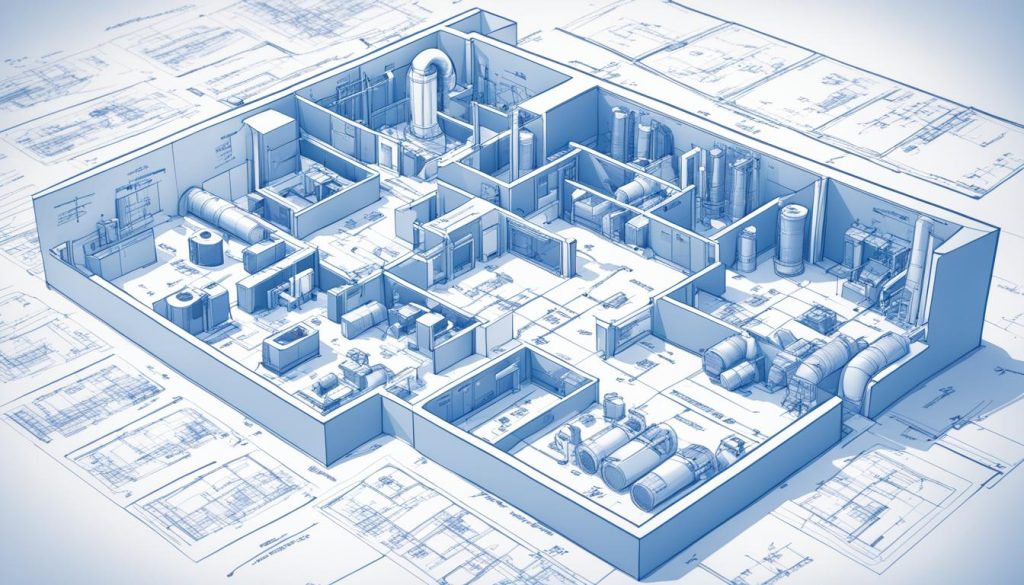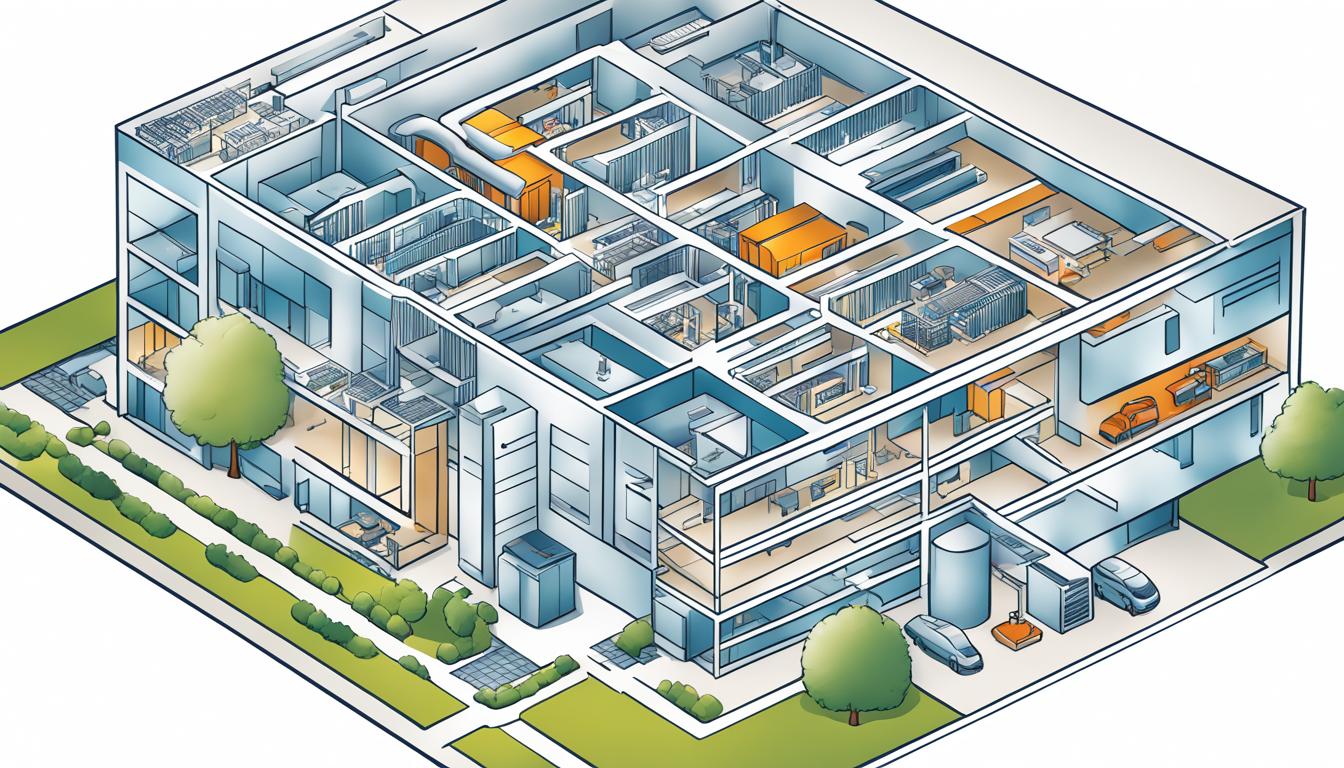To make sure your HVAC designs follow building codes, you must know the rules from the International Code Council (ICC). The International Energy Conservation Code (IECC) and International Residential Code (IRC) are key for designing HVAC systems in homes.
Building codes in the USA are key for safety, health, and keeping communities safe. They set rules for energy efficiency and air flow that HVAC designs must follow. By sticking to these codes, you make systems that are legal, work well, and keep people comfortable.
The IECC is all about saving energy in buildings, both big and small. The IRC deals with the design and building of single-family homes and townhouses. Knowing these codes is crucial for HVAC designs that are up to code and efficient.
Understanding Building Codes for HVAC Systems
Building codes are key for HVAC system design and setup. They make sure systems are safe, comfy, and use energy wisely in homes and businesses. Let’s look at the main parts of HVAC building codes and why they matter in designing systems.
The Role of the International Code Council
The International Code Council (ICC) creates model codes for safety and energy efficiency in buildings. These codes are the base for HVAC design rules in the U.S. The ICC’s work makes building practices consistent and ensures quality in construction and system setup.
Key HVAC-related Codes
Two main codes rule HVAC systems: the International Energy Conservation Code (IECC) and the International Residential Code (IRC). The IECC is all about saving energy, while the IRC looks at residential building rules, including HVAC setups.
| Code | Focus | Key Areas |
|---|---|---|
| IECC | Energy Efficiency | Insulation, Fenestration, Equipment Efficiency |
| IRC | Residential Construction | HVAC Installation, Ventilation, Safety Standards |
Importance in HVAC Design
Building codes help HVAC designers make systems right for different climates. They cover things like how big the equipment should be, how ducts should be made, and how much air should flow. Following these codes makes sure your HVAC system works well and safely.
It’s key to know and use these building codes when designing HVAC systems. This way, you get systems that work great and meet legal and safety rules. Remember these rules when designing your HVAC system for the best results for your building.
The International Energy Conservation Code (IECC)
The IECC is key in setting energy-saving standards for buildings in the U.S. It aims to make HVAC systems and other building parts more energy-efficient. Let’s look at important parts of the IECC that affect HVAC design and setup.
Climate Zones
IECC Section R301.1 splits the country into climate zones. These zones help figure out the right energy-saving steps based on where you are. For instance, homes in cold areas need more insulation than those in warm areas.
Insulation and Fenestration Criteria
Section R402.1.2 of the IECC sets insulation standards for different building parts. It also outlines rules for windows and doors (fenestration). These rules change with the climate zone to help save energy.
| Climate Zone | Ceiling R-Value | Wall R-Value | Window U-Factor |
|---|---|---|---|
| 1 | 30 | 13 | 0.50 |
| 3 | 38 | 20 | 0.30 |
| 5 | 49 | 20+5 | 0.30 |
| 7 | 49 | 20+5 | 0.30 |
Duct Design Requirements
IECC Section R403.3 deals with duct design and setup. It covers insulation, sealing, and testing requirements. Good duct design is key for efficient HVAC operation. The code sets a minimum R-value for duct insulation based on location and climate zone.
Knowing these IECC rules is vital for HVAC pros. Following these standards ensures energy-efficient systems that meet building codes and keep occupants comfortable.
The International Residential Code (IRC)
The IRC sets the standard for residential HVAC requirements in the United States. It covers one- and two-family dwellings. This means it gives important rules for homeowners and contractors. It’s key to know the IRC guidelines to make sure your HVAC system is safe and efficient.
IRC guidelines cover many HVAC aspects. They talk about insulation, windows, and duct design. These rules help make homes more energy-efficient and comfortable for people living there.
The mechanical systems code in the IRC is all about safety and performance. It has rules for equipment size, air flow, and controls. Following these rules helps make a safe and efficient HVAC system for your house.
| IRC Section | Focus Area | Key Requirements |
|---|---|---|
| N1102.2 | Insulation | R-value specs for walls, attics, and floors |
| N1102.3 | Fenestration | U-factor and SHGC limits for windows and doors |
| M1601.1 | Duct Design | Sizing, materials, and how to install |
The IRC has rules for HVAC design, setup, and how it works. These rules make sure your HVAC system works well and keeps the air clean. By following IRC standards, you can make your home safe and comfy.
Ensure Designs Meet Building Code Requirements
Building codes are key in designing HVAC systems. You must focus on three main areas: HVAC equipment sizing, duct design, and whole-house mechanical ventilation.
Equipment Sizing and Efficiency Rating
Getting the right size for HVAC equipment is crucial for good performance. The IECC and IRC require sizing based on ACCA Manual S. This uses load calculations from ACCA Manual J. Your equipment must have energy efficiency ratings that meet or beat the minimum for your area.

Duct Design Requirements
Good duct design is vital for efficient air flow. Codes say duct systems must be designed using ACCA Manual D or similar methods. This method cuts energy loss and boosts system performance.
Whole-House Mechanical Ventilation
Mechanical ventilation keeps indoor air clean. If your home leaks air at 5 changes per hour or less at 50 Pa, you need whole-house ventilation. The amount of ventilation needed depends on your home’s size and number of bedrooms.
| Home Size (sq ft) | Bedrooms | Ventilation Rate (cfm) |
|---|---|---|
| 1500 | 2 | 45 |
| 2000 | 3 | 60 |
| 2500 | 4 | 75 |
Following these guidelines for HVAC equipment, energy efficiency, and ventilation ensures your designs meet building codes. This also guarantees comfort and efficiency for your home.
HVAC System Design Process
The HVAC system design process has three key steps. These steps make sure your heating and cooling system follows building codes. They include load calculations, picking the right equipment, and designing the ducts. This process helps create an efficient and effective HVAC system for your home or building.
Manual J: Load Calculations
ACCA Manual J is the top method for calculating HVAC loads. It looks at your building’s size, insulation, and local weather to figure out what you need. Getting this right is key to picking the right equipment and saving energy.
Manual S: Equipment Selection
After calculating the loads, ACCA Manual S helps pick the right HVAC equipment. This makes sure the system can efficiently handle the loads. Choosing the right equipment stops problems like short cycling and poor temperature control.
Manual D: Duct Design
The last step is designing the ducts with ACCA Manual D. This guide helps create a duct system that sends the right amount of air to each room. A well-designed duct system is key for comfort and saving energy in your building.
| Manual | Purpose | Key Factors |
|---|---|---|
| Manual J | Load Calculations | Building size, insulation, climate |
| Manual S | Equipment Selection | Calculated loads, system efficiency |
| Manual D | Duct Design | Airflow requirements, duct sizing |
Using these ACCA manuals and doing precise load calculations leads to a system that meets codes and offers the best comfort and efficiency for your space.
Energy Efficiency Standards and Requirements
Energy code adoption is key in shaping HVAC designs in the U.S. State energy codes differ, reflecting various climates and priorities. It’s important to know these rules to make sure your HVAC projects follow the law and save energy.
The DOE helps states update their energy codes. The Department of Energy looks at new standards and suggests they be adopted. For instance, in 2014, the DOE asked states to use ASHRAE Standard 90.1-2013 or something similar by September 2016. This change was expected to reduce energy use by 8.7% from the 2010 level.

To understand these rules, talk to your local permitting agencies. They know the energy codes that apply in your area. Remember, these standards change as technology gets better and environmental issues become more urgent.
| Energy Code Component | Key Considerations |
|---|---|
| Insulation Requirements | R-values for walls, ceilings, floors |
| Window Efficiency | U-factor and Solar Heat Gain Coefficient |
| HVAC Equipment Efficiency | Minimum SEER ratings for air conditioners |
| Lighting Efficiency | Lumens per watt requirements |
| Air Sealing | Maximum air leakage rates |
Keep up with energy code trends and DOE updates to design HVAC systems that meet rules and save energy. This way, you help your clients and the planet, making you a forward-thinking HVAC pro.
Ventilation and Indoor Air Quality Regulations
Good indoor air quality is key for your health and comfort. Building codes set ventilation standards to keep air moving and clean in homes and businesses. Let’s look at what these regulations cover.
Minimum Ventilation Rates
The International Residential Code (IRC) sets a minimum ventilation rate. This depends on your home’s size and number of bedrooms. For instance, a 2,000-square-foot home with three bedrooms needs about 60 cubic feet per minute (CFM) of ventilation.
Demand-Controlled Ventilation
In places with lots of people, demand-controlled ventilation systems adjust airflow automatically. They use sensors to check how many people are there and the CO2 levels. When needed, they turn up the ventilation to keep the air fresh and efficient.
| Occupancy Level | CO2 Concentration (ppm) | Ventilation Rate (CFM/person) |
|---|---|---|
| Low | 400-600 | 5-10 |
| Medium | 600-800 | 10-15 |
| High | 800-1000 | 15-20 |
Air Filtration Standards
Good air filtration is key to removing harmful particles from your air. ASHRAE Standard 52.2 outlines air filter efficiency. The MERV rating system helps you pick the right filter for your HVAC. Higher ratings mean better filtering of tiny particles.
Following these ventilation and air quality rules makes your space healthier and more comfy. Keeping your HVAC system in good shape and using proper ventilation helps meet building codes. This also boosts the air quality in your home or office.
Code Compliance for HVAC Controls and Zoning
HVAC control systems and zoning are key to meeting building codes. They help make sure your HVAC design follows the rules and saves energy. Modern HVAC systems use smart controls to manage temperature, humidity, and air quality in different zones.
Building codes require specific control strategies for HVAC systems. This includes programmable thermostats that let you set different temperatures for different times. Optimal start controls adjust when the system starts based on the weather and how many people are in the building. These smart controls cut down on energy use without making people uncomfortable.
Zoning is a big part of HVAC design that codes pay attention to. It means dividing a building into areas with their own temperature controls. This way, you can heat or cool only the parts of the building that need it. Proper zoning can save a lot of energy, especially in buildings with changing use or different areas.
When planning your HVAC system, think about adding energy management systems. These systems can watch and improve your HVAC’s performance. They make sure you follow the building codes and waste less energy. With efficient controls and smart zoning, you can make an HVAC system that meets the rules and keeps everyone comfortable.





0 Comments